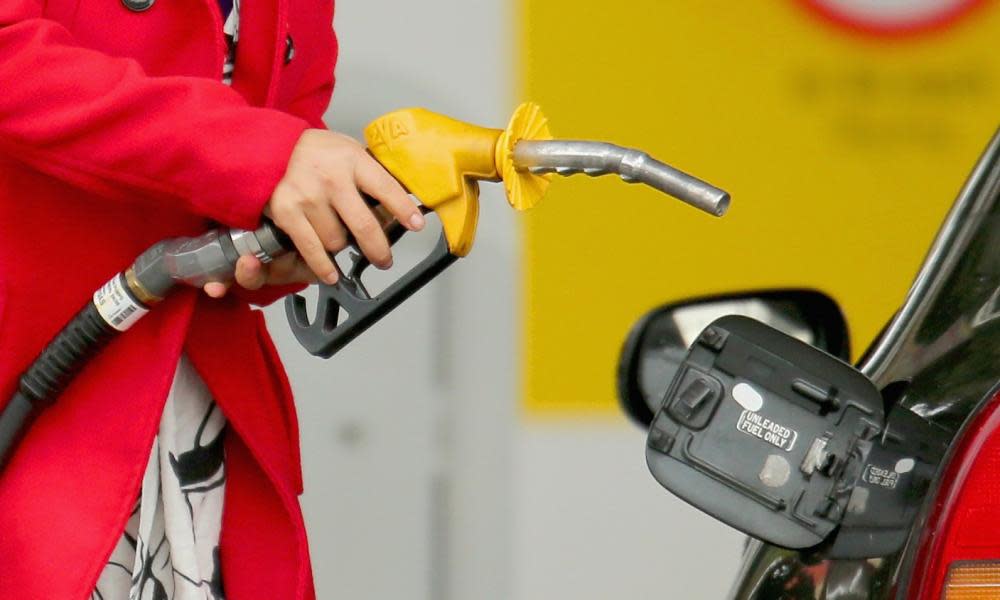'Among the worst in OECD': Australia's addiction to cheap, dirty petrol

Australia’s cheap, dirty petrol ranks among the worst of the OECD nations, yet the peak industry body representing Australian petrol refiners has rejected the criticism, saying the industry should be given until 2027 to adjust to stricter regulations.
Paul Barrett, the chief executive of the Australian Institute of Petroleum, hit back at critics who have described Australian petrol as low quality thanks to its sulphur content.
“There are a range of fuel parameters which determine the quality of fuel, not just the sulphur content of any fuel,” Barrett said. “Australian fuel is very high quality fuel, and better than many countries for some key fuel parameters like MTBE [methyl tert-butyl ether] and olefins.”
There are currently 17m registered cars on Australian roads, the second biggest source of greenhouse gas pollution, according to the Climate Council. Collectively they produce almost the same emissions each year as Queensland’s coal and gas-fired electricity supply.
Other countries have looked to fuel quality as a first step in lowering the carbon dioxide emissions of cars and other road transport because it is easy to legislate, while also encouraging a transition to cleaner technologies such as electric vehicles.
High octane, low sulphur fuels are the gold standard for vehicle manufacturers but the current unleaded petrol on the Australian market ranks among the worst of OECD nations on its sulphur content.
A 2015 report by oil and gas consultants Stratas Advisors ranked 100 countries by the sulphur content of their fuels and found Australia landed at 66.
Tony Weber, the CEO of the Federal Chamber of Automotive Industries (FCAI), told the Senate select committee into electric vehicles that simply improving fuel quality would offer a “3%-5%” improvement on CO2 performance “overnight”.
“Australia has one of the lowest-quality fuels in the OECD,” Weber said. “The vast majority of the 17 million fleet would get the improvement just from the change of fuel with no change to the vehicle.”
While the actual sulphur content in Australian fuels is lower than the regulated limit, current legislation allows for up to 150 parts per million for regular unleaded petrol and 50 parts per million for premium fuels.
Dr Vlado Vivoda, a research fellow with the Sustainable Minerals Institute at the University of Queensland, said Australia’s fuel had also stayed cheap, which meant the quality had not improved.
“Fuel prices are low in comparison to other OECD countries,” Vivoda said. “It is probably in the bottom three.
“That doesn’t encourage any kind of innovation or shift away from those fuels. If you’ve got fuel prices that are a bit higher, alternatives start to become more cost competitive.”
Across the world, acceptable emissions levels for new petrol cars are regulated under the European Emission Standards. Currently best practice is represented by the stringent “Euro 6” regulations, which have been adopted by a number of Australia’s major trading partners
Australia’s current standard is Euro 5.
The ministerial forum on vehicle emissions – which has been criticised over its inaction – was set up to address the issue of a transition and outlined three proposals in its Better Fuels for Cleaner Air 2018 discussion paper, which was released last year.
Of these, one would give the refining industry until 2027 to do away with regular unleaded petrol even as stricter fuel efficiency standards were introduced.
This plan was attacked last August by Toyota’s head of sales and marketing, Sean Hanley, who criticised the introduction of stricter fuel efficiency standards without also ensuring the availability of cleaner fuels on which to run them.
“Put simply, we can’t achieve first-world emissions without our first-world quality fuel,” Hanley told media in Brisbane.
But the head of Australian Institute of Petroleum said it would cost $979m to upgrade Australia’s four remaining refineries to produce low-sulphur fuels, and would put them at risk of closing with a tougher deadline.
Barrett said: “We can’t do it, it’s going to take us over five years to build the required equipment, and we have to accommodate all of the Australian refineries and their unique circumstances.”
While the industry has agreed to provide low-sulphur fuels by 2027 – around the time electric cars are projected to hit price parity with petrol engines – Barrett said the fuel was not needed to ensure the introduction of vehicles with the latest technology.
“There are Euro 6 cars running around Australia now in the marketplace, operating on the current market fuel quality and are meeting the emissions standards,” Barrett said. “We’ve not been aware of any operability issues with these vehicles or any breaches of environmental standards.”
The Federal Chamber of Automotive Industry’s technical director, James Hurnall, disagreed.
“The Euro 6 standard requires the vehicle to continue to meet emissions standards for 160,000 km,” Hurnall said. “Car markers know systems can deteriorate in service. If the market fuel isn’t right, the deterioration may happen more quickly. And you may get higher levels of emissions than you would using the correct fuel.”

 Yahoo News
Yahoo News 
